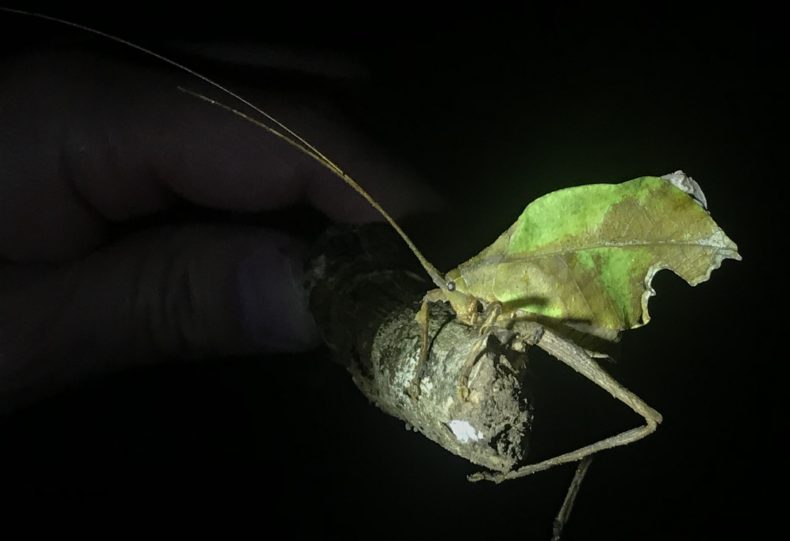
Earlier this month, on a night hike in Costa Rica’s Monteverde cloud forest, I made the acquaintance of the above insect, which, best I can tell, is a member of the Pterochrozinae, a group commonly known as the leaf-mimic katydids. (Entomologists, please correct me!) Walter, our guide, found this individual, which is fortunate because I never could have. Examining this photo anew, I’m freshly astonished by the detail of this katydid’s impeccable camouflage: the green-and-brown mottling of the dying “leaf” (which also serves to break up the critter’s silhouette), the well-defined midrib, the delicate veining. My favorite grace note is the missing chunk along the wing’s underside — a feigned attack from a colony of leafcutter ants.
Leaf-mimic katydids are — pardon the cliché — the snowflakes of the insect world. (I’m talking here about their uniqueness, not their emotional fragility in the face of online trolling.) Seldom do two individuals, let alone two species, look alike. Their remarkable diversity is nicely illustrated in a 1995 paper by James Castner and David Nickle, entomologists who began collecting katydids in Peru in 1986. Castner and Nickle note that many leaf-mimics are “polymorphic” — i.e., divided into several distinct forms — and that some species come in as many as seven flavors. Take Typophyllum bolivari, which has four very different morphs: “overall color dark green”; “irregular blotchy pattern of medium and light browns, some approaching pink in color”; “overall monochromatic medium brown”; and “generally dark brown” with “two well-developed transparent elliptical areas.” Fake holes, in other words, in the middle of a fake leaf.
What’s the point of this elegant variation, which dates back at least to the Permian? As Castner and Nickle point out, if every leaf-mimicking katydid mimicked the same leaf — say, a blotchy brown one with a thick midrib and a bit of ant-chew along the top edge — predators would quickly figure out the gambit. By widely varying their appearance, the insects prevent their enemies from “receiv(ing) sufficient positive reinforcement” to “develop a search image for its prey.” As ever, natural selection keeps ’em guessing.
Leaf-mimic katydids are so good they fool taxonomists as well as birds and monkeys. According to the Biomimicry Institute, more than a fifth of the group’s species have been erroneously described multiple times — apparent new species that, upon closer review, turned out merely to be distinct morphs. Spare some sympathy for all the collectors who thought they’d discovered a sui generis katydid, only to learn they’d been tricked by a bit of entomological elegant variation.